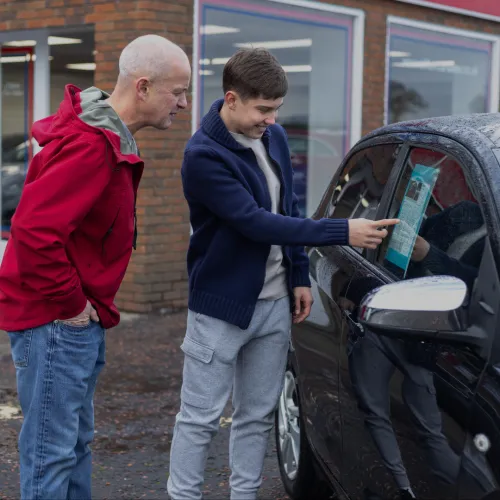
You're scrolling through Facebook Marketplace when you spot a nearly new ATV listed at half the market price. The seller says they need quick cash and can meet you that evening. It seems like the deal of a lifetime. But three weeks later, RCMP officers are at your door with a warrant to seize the ATV. Turns out, it was stolen from a farm near Leduc. Now you're out both your money and the machine you'd bought.
This plays out more often than you might think across Alberta. When you unknowingly purchase stolen property, you could face serious legal consequences if the courts determine you "should have known" the item was stolen. Worse yet, your purchase directly supports criminal networks that target our communities.
The good news is that you can protect yourself by verifying a few things before you go through with the deal. Whether you're planning to buy a used truck, equipment, or electronics, we’ll show you how to spot red flags, verify items, and document your purchases safely.
Red Flags to Watch For Before You Meet
Trust your instincts when something feels off about a listing or seller. Here are the warning signs to watch out for.
- Price far below market value or urgent "must sell today" pressure
- New seller profile or unwillingness to verify their identity over the phone
- Refusing to share VIN/serial numbers or provide clear photos of identification plates
- Requesting to meet in remote locations or insisting on odd hours
- Cash-only transactions with no willingness to provide a bill of sale
If any of these red flags stack up, put the deal on hold. It's better to miss out on a great deal than to lose your money to a scam.
How to Verify Your Potential Purchase Wasn’t Stolen
Step 1: Collect Information Before You Meet
-
For vehicles/trailers/ATVs: 17-character VIN
-
For bikes/electronics/tools: Serial number, brand, and model
-
Additional info: License plate (if applicable), registration details, and photos of ID plates
Step 2: Check Documents and Seller Info
-
Compare the VIN on the frame/dash/door jamb with registration documents
-
Ensure names on ownership documents match the seller's photo ID
-
Watch for obvious errors
Step 3: Inspect for Tampering
-
Ground-off or restamped VIN/serial numbers
-
Mismatched rivets or mounting hardware around ID plates
-
Uneven paint, primer spots, or stickers covering ID areas
-
On bikes and tools: filed serial numbers, missing manufacturer stickers, or unusual grinding marks
Step 4: Run a Market Sense Check
-
Compare the asking price with similar listings online
-
Ask about service records, owner's manuals, spare keys, or original receipts
-
Question why they're selling and how long they've owned it
Step 5: Run a CPIC Check
The Canadian Police Information Centre (CPIC) is your first line of defence against purchasing stolen property. This national police database lets you search VINs for vehicles, motorcycles, off-road vehicles, and trailers.
What makes CPIC useful is that it's not just for cars. You can check ATVs, snowmobiles, trailers, motorcycles — pretty much anything with a VIN.
Safe Meeting and Payment Practices
If you have checked that what you are purchasing is legitimate, or you still need to gather more information in person, it is still important to be careful when meeting and exchanging cash. You may have exchanged a few messages with this person, but you don’t know who they are and what their real intentions are.
When choosing a location to meet, suggest a well-lit public place that you’re familiar with, ideally near a police station or with security cameras. Avoid isolated locations, especially after dark.
Once you have a location set, plan to take someone with you. If you aren’t able to arrange to have a friend come with you, let someone know where you're going, when, and who you're meeting.
When it comes to paying for the vehicle or equipment, avoid large cash transactions whenever possible. Consider bank drafts, certified cheques, or e-transfers for traceability.
If you choose to provide payment through e-transfer, be wary of any links the seller may provide for sending the e-transfer — it may be a phishing scam to get access to your online banking information.
What to Do If You Suspect an Item Is Stolen
If something doesn't feel right during your interaction, it’s important not to confront the seller, as this could put you in danger. Instead, take note of important details such as the location, time, license plates, phone numbers, and online listing addresses. You should contact the authorities by calling your local RCMP detachment or the municipal police non-emergency line. Additionally, keep any evidence you may have, including screenshots, messages, photos, and other documentation. Remember that if you suspect criminal activity, it’s always better to report it and be mistaken than to ignore a potential issue and let a criminal go unpunished.
Your Pre-Purchase Checklist
If you frequently use Facebook Marketplace or plan to buy a secondhand vehicle, consider downloading this handy checklist to stay safe from criminals and avoid purchasing stolen items.
Resources and Links
The thrill of scoring a great deal can easily turn into a nightmare if you unknowingly purchase stolen property. By keeping an eye out for red flags, verifying key information, and following safe meeting and payment practices, you significantly reduce the risk of falling victim to scams. Remember to trust your instincts and prioritize your safety first—it's better to walk away from a questionable deal than to face the consequences later. A few minutes spent verifying can help keep your money safe and prevent stolen goods from circulating in our communities.

October 01, 2025
